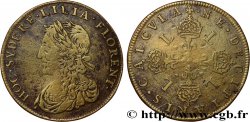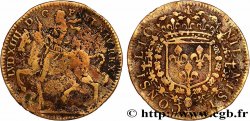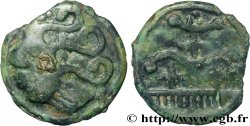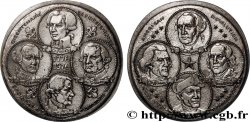v11_0874 - CONSEIL DU ROI / KING'S COUNCIL Henri III 1575
MONNAIES 11 (2002)
Starting price : 121.96 €
Estimate : 304.90 €
Realised price : 229.89 €
Number of bids : 2
Maximum bid : 335.39 €
Starting price : 121.96 €
Estimate : 304.90 €
Realised price : 229.89 €
Number of bids : 2
Maximum bid : 335.39 €
Type : Henri III
Date: 1575
Metal : silver
Diameter : 28 mm
Orientation dies : 6 h.
Weight : 4,52 g.
Edge : lisse
Rarity : R3
Coments on the condition:
Ce jeton est frappé sur un flan large et régulier ; il présente une patine grise. On doit noter une faiblesse de frappe sur le haut de l’écu de France et une rayure au-dessus de l’éléphant
Catalogue references :
Obverse
Obverse legend : (ROSETTE) NIL. NISI / CONSILIO (ROSETTE).
Obverse description : Écu de France couronné et entouré du collier de l’ordre de Saint-Michel dont le bijou coupe la légende à 6 heures.
Obverse translation : (Rien sans le Conseil).
Reverse
Reverse legend : (ROSETTE) PLACIDIS PARCIT..
Reverse description : Un éléphant avançant à gauche, un serpent sous ses pattes arrières, des moutons en arrière plan devant lui ; à l’exergue, 1575.
Commentary
On note au droit deux rosettes à quatre pétales tandis qu’au début de la légende du revers il s’agit d’une rosette à six pétales, creuse en son centre.
Le revers de ce jeton ne semble répertorié dans aucun des ouvrages de référence. Il est pourtant connu par une reproduction dans l’ouvrage de Jacques de Bie, Histoire de la France métallique, Paris, 1636, pl.74. Cet ouvrage est souvent jugé peu sûr car de nombreuses gravures semblent n’avoir existé que dans l’imagination de De Bie, ce qui est probable, mais ce jeton est la preuve que certains jetons reproduits dans De Bie et actuellement non signalés peuvent encore être retrouvés. Voici ce que dit De Bie de ce revers : “Le Corps est d’un éléphant passant par une campagne, où trouvant des moutons en son chemin il revolte sa trompe vers son front, pour marquer qu’il n’a aucune intention de leur nuire : Et au contraire, marche d’un pied sur un serpent, qui semble s’estre glissé sous son ventre pour luy nuire. Sous l’exergue : MDLXXV. Pour marquer de la clémence du monarque exercée envers ceux de ses subjects, qui demeuroient dans leur devoir ; & de sa sévérité contre ceux qui se rendoient rebelles à ses commandements”. Ce jeton est inspiré d’un denier de Jules César.
On the right we note two rosettes with four petals while at the beginning of the legend on the reverse there is a rosette with six petals, hollow in its center.
The reverse of this token does not appear to be listed in any reference works.. However, it is known from a reproduction in the work of Jacques de Bie, History of Metallic France, Paris, 1636, pl. 74. This work is often considered unreliable because many of the engravings seem to have existed only in De Bie's imagination, which is likely, but this token is proof that some tokens reproduced in De Bie and currently unreported can still be found.. Here is what De Bie says about this reverse: “The Body is of an elephant passing through a countryside, where finding sheep in its path it turns its trunk towards its forehead, to show that it has no intention of harming them: And on the contrary, steps with one foot on a snake, which seems to have slipped under its belly to harm it.. Under the exergue: MDLXXV. To mark the clemency of the monarch exercised towards those of his subjects who remained in their duty; and his severity against those who rebelled against his commands”. This token is inspired by a denarius of Julius Caesar
Le revers de ce jeton ne semble répertorié dans aucun des ouvrages de référence. Il est pourtant connu par une reproduction dans l’ouvrage de Jacques de Bie, Histoire de la France métallique, Paris, 1636, pl.74. Cet ouvrage est souvent jugé peu sûr car de nombreuses gravures semblent n’avoir existé que dans l’imagination de De Bie, ce qui est probable, mais ce jeton est la preuve que certains jetons reproduits dans De Bie et actuellement non signalés peuvent encore être retrouvés. Voici ce que dit De Bie de ce revers : “Le Corps est d’un éléphant passant par une campagne, où trouvant des moutons en son chemin il revolte sa trompe vers son front, pour marquer qu’il n’a aucune intention de leur nuire : Et au contraire, marche d’un pied sur un serpent, qui semble s’estre glissé sous son ventre pour luy nuire. Sous l’exergue : MDLXXV. Pour marquer de la clémence du monarque exercée envers ceux de ses subjects, qui demeuroient dans leur devoir ; & de sa sévérité contre ceux qui se rendoient rebelles à ses commandements”. Ce jeton est inspiré d’un denier de Jules César.
On the right we note two rosettes with four petals while at the beginning of the legend on the reverse there is a rosette with six petals, hollow in its center.
The reverse of this token does not appear to be listed in any reference works.. However, it is known from a reproduction in the work of Jacques de Bie, History of Metallic France, Paris, 1636, pl. 74. This work is often considered unreliable because many of the engravings seem to have existed only in De Bie's imagination, which is likely, but this token is proof that some tokens reproduced in De Bie and currently unreported can still be found.. Here is what De Bie says about this reverse: “The Body is of an elephant passing through a countryside, where finding sheep in its path it turns its trunk towards its forehead, to show that it has no intention of harming them: And on the contrary, steps with one foot on a snake, which seems to have slipped under its belly to harm it.. Under the exergue: MDLXXV. To mark the clemency of the monarch exercised towards those of his subjects who remained in their duty; and his severity against those who rebelled against his commands”. This token is inspired by a denarius of Julius Caesar







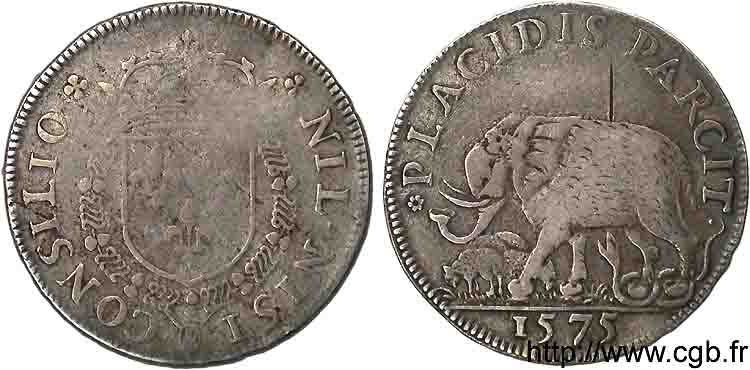
 Report a mistake
Report a mistake Print the page
Print the page Share my selection
Share my selection Ask a question
Ask a question Consign / sell
Consign / sell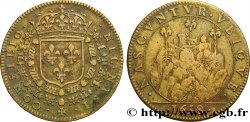
 Full data
Full data